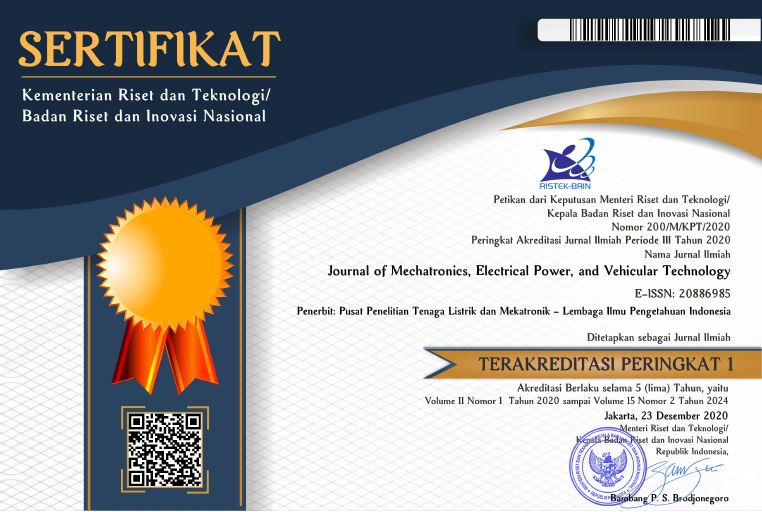A study effects of injection pressure and wall temperature on the mixing process of NOx and NH3 in Selective Catalytic Reduction system
Abstract
Diesel engines are commonly used for public transportation on-road and off-road applications. Growth production of the diesel engine is very significant from year to year. Nitride Oxide (NOx) from diesel engine was one of the major sources of air pollution. Selective Catalytic Reduction (SCR) has been successfully used to reduce NOx from a diesel engine with a chemical reaction from ammonia (NH3). The mixing reaction between NOx and NH3 reaction can produce steam (H2O) and Nitrogen (N2). However, ammonia uniformity pattern usually not homogenization and the ammonia was difficult to mix with NOx. The constant air flows incomplete to assist the spray injector to spread NH3 to all corners of SCR. The impact study of turbulent phenomena and standard k-epsilon Low-Reynolds Number model to the mixing process in the SCR system using STARCCM+. The simulation studies are conducted under different pressure (4 to 6 bars), the injection rate (0.04 g/s) and temperature (338 K – 553 K) and the high pressure and high velocity magnitude creating turbulent swirl flow. The ammonia decomposition process and mixing process with NOx were investigated using a box with optical access. The simulation and numerical study results validated using back pressure value and the distribution of NOx concentration value from the catalyst outlet. The wall temperature will increase the urea evaporation to generate ammonia and gas pressure will increase the mixing process and chemical process in the SCR system. These reactions enable to optimize the SCR system technology which eventually able to reduce the NOx quantity from a diesel engine.
Keywords
Full Text:
PDFReferences
R. Conway, S. Chatterjee, M. Naseri, and C. Aydin, “Demonstration of SCR on a Diesel Particulate Filter System on a Heavy Duty Application,” SAE Int., 2015. crossref
H. Smith, T. Lauer, V. Schimik, and K. Gabel, “Evaluation and Prediction of Deposit Severity in SCR Systems,” SAE Int. J. Engines, vol. 9, no. 3, pp. 2016-01–0970, 2016. crossref
J. Baleta, H. Mikulčić, M. Vujanović, Z. Petranović, and N. Duić, “Numerical simulation of urea based selective non-catalytic reduction deNOx process for industrial applications,” Energy Convers. Manag., 2016. crossref
M.K.A. Wardana, G.M.H. Shahariar, K. Oh, and O. Lim, “Ammonia uniformity to predict NOx reduction efficiency in an SCR system,” Int. J. Automot. Technol., vol. 20, no. 2, pp. 313–325, 2019. crossref
H. Smith, M. Zöchbauer, and T. Lauer, “Advanced Spray Impingement Modelling for an Improved Prediction Accuracy of the Ammonia Homogenisation in SCR Systems,” SAE Tech. Pap., 2015. crossref
P. Gaynor, B. Reid, G. Hargrave, T. Lockyer, and J. Wilson, “An Experimental Investigation into DEF Dosing Strategies for Heavy Duty Vehicle Applications,” SAE Int. J. Engines, vol. 8, no. 3, pp. 1196–1206, 2015. crossref
M.K.A. Wardana, K. Oh, Y. J. Lee, Y. M. Woo, and O. Lim, “Effects of urea injection timing on predicting NOX conversion in SCR systems,” Int. J. Automot. Technol., vol. 21, no. 1, pp. 137–145, 2020. crossref
G.M.H. Shahariar, M.K.A. Wardana, and O. T. Lim, “Investigation of urea-water solution spray impingement on the hot surface of automotive SCR system,” J. Mech. Sci. Technol., vol. 32, no. 6, pp. 2935–2946, 2018. crossref
X. Auvray et al., “Kinetic modeling of NH3-SCR over a supported Cu zeolite catalyst using axial species distribution measurements,” Appl. Catal. B Environ., vol. 163, no. 2, pp. 393–403, 2015. crossref
S. Fischer, R. Bitto, T. Lauer, C. Krenn, J. Tauer, and G. Pessl, “Impact of the Turbulence Model and Numerical Approach on the Prediction of the Ammonia Homogenization in an Automotive SCR System,” SAE Int. J. Engines, vol. 5, no. 3, pp. 1443–1458, 2012. crossref
Y. Yi, “Development of a 3D Numerical Model for Predicting Spray, Urea Decomposition and Mixing in SCR Systems,” SAE Int., no. 724, 2007. crossref
J. Baleta, M. Vujanović, K. Pachler, and N. Duić, “Numerical modeling of urea water based selective catalytic reduction for mitigation of NOx from transport sector,” J. Clean. Prod., vol. 88, pp. 280–288, 2015. crossref
M. Colombo, I. Nova, E. Tronconi, V. Schmeiβer, and M. Weibel, “Mathematical modelling of cold start effects over zeolite SCR catalysts for exhaust gas aftertreatment,” Catalysis Today, vol. 231. pp. 99–104, 2014. crossref
B. Opitz et al., “Simulation study of SCR catalysts with individually adjusted ammonia dosing strategies,” Chemical Engineering Journal, vol. 264. pp. 936–944, 2015. crossref
H. Nishiyama, Y. Tanaka, and T. Adachi, “A study on the improvement of NOx reduction efficiency for a Urea SCR System,” SAE Tech. Pap., vol. 46, no. 3, pp. 589–595, 2015. crossref
T. Lockyer, B. Reid, G. Hargrave, P. Gaynor, and J. Wilson, “Optical investigation on the ability of a Cordierite substrate mixing device to combat deposits in SCR dosing systems,” SAE Tech. Pap., vol. 2015-April, no. April, 2015. crossref
M. Zöchbauer, H. Smith, and T. Lauer, “Advanced SCR flow modeling with a validated large Eddy simulation,” SAE Int., vol. 1046, no. 3, p. 14, 2015. crossref
Article Metrics
Metrics powered by PLOS ALM
Refbacks
- There are currently no refbacks.
Copyright (c) 2020 Journal of Mechatronics, Electrical Power, and Vehicular Technology

This work is licensed under a Creative Commons Attribution-NonCommercial-ShareAlike 4.0 International License.
Cited-By
1. Numerical Analysis of the Structural and Flow Rate Characteristics of the Fuel Injection Pump in a Marine Diesel Engine
Binyamin Binyamin, Ocktaeck Lim
Sustainability vol: 15 issue: 11 first page: 8948 year: 2023
doi: 10.3390/su15118948




















